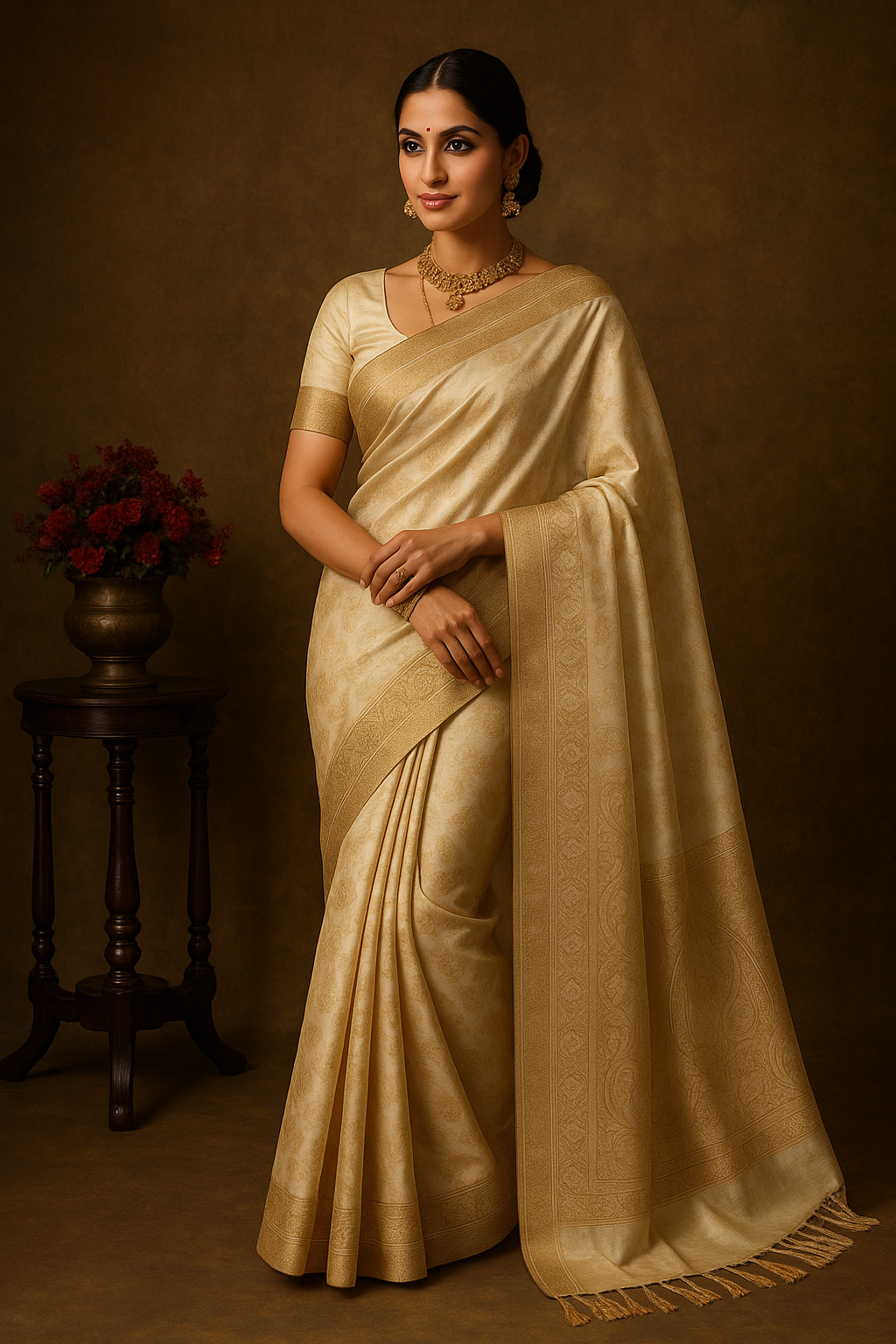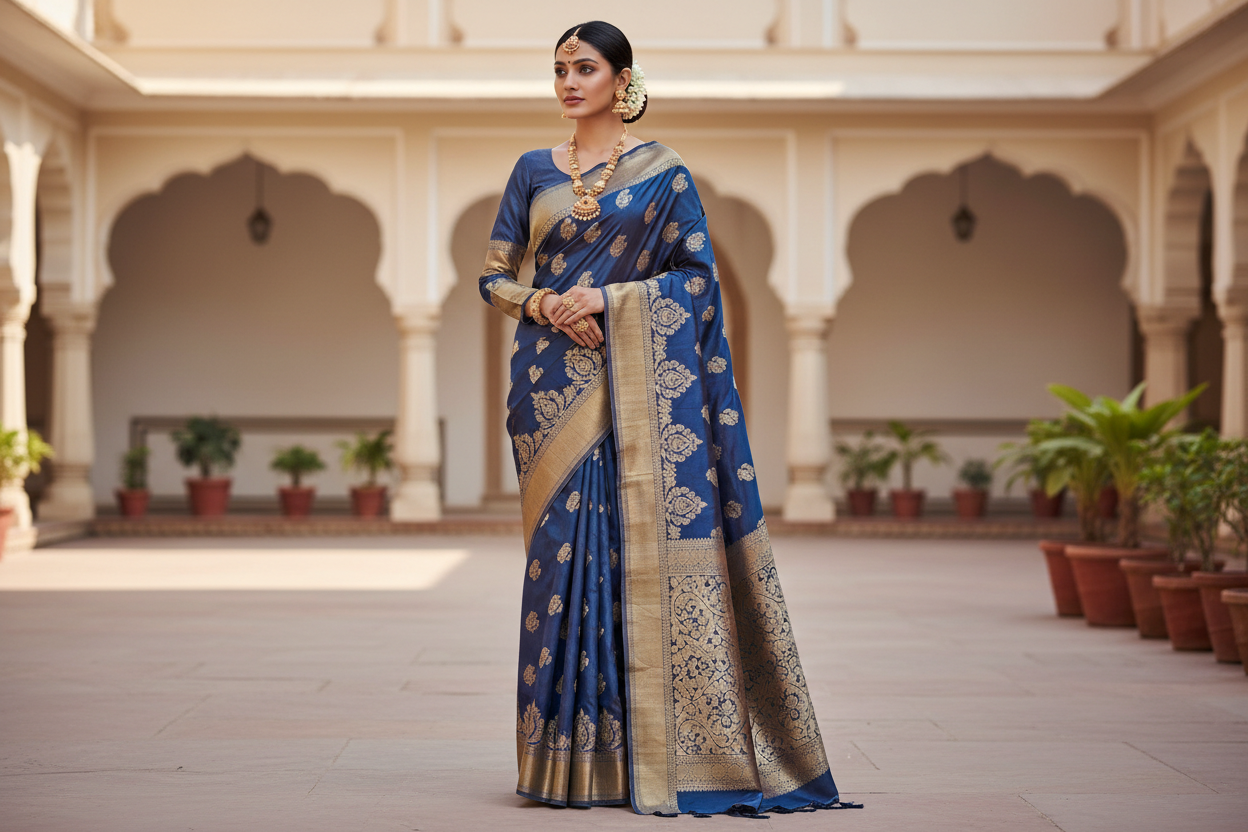The saree, an epitome of grace and tradition, has transcended centuries and trends, establishing itself as a timeless fashion icon in Indian culture. Worn by millions of women across India and the world, the saree is not merely a piece of clothing—it is a symbol of heritage, pride, femininity, and elegance. Whether draped in the lanes of Varanasi, showcased on international runways, or embraced during festivals, the saree continues to captivate hearts across generations.
At Jalpari Fashion, we understand the emotional and cultural value of a saree. Our collections celebrate this timeless legacy while blending modern charm with traditional essence.
1. The Origin and Ancient Glory of the Saree
The history of the saree can be traced back to the Indus Valley Civilization (2800–1800 BCE), where early sculptures and figurines depicted women wearing draped clothing resembling the saree. Unlike stitched garments, the saree was born from a philosophy of simplicity and elegance—just a single length of cloth, skillfully wrapped around the body.
Back in ancient times, sarees were worn without a blouse or petticoat. They were draped gracefully in ways that suited the climate, culture, and regional customs. Temples and ancient artwork display goddesses and women in sarees, reinforcing its significance across spiritual, cultural, and artistic realms.
2. Sarees in Historical Dynasties
As India saw the rise of powerful dynasties like the Mauryas, Guptas, Cholas, and Mughals, the saree continued to evolve in style and textile. The Banarasi saree, which originated in Varanasi, was inspired by Mughal designs, incorporating gold zari, intricate brocade work, and floral patterns.
In South India, Kanjeevaram silk sarees became symbols of opulence. Woven with mulberry silk and bordered with gold threads, these sarees were associated with weddings, festivals, and temple rituals.
During the colonial era, although Western fashion began influencing Indian attire, the saree retained its cultural stronghold, adapted in new ways by educated and elite women. The Nivi style—tucking the pleats in the center and draping the pallu over the shoulder—became widely popular, thanks to social reformers and the influence of Rabindranath Tagore's family in Bengal.
3. Sarees as a Cultural Identity
Each region in India has its unique saree tradition:
-
Banarasi Sarees – Northern India, known for zari and brocade.
-
Kanjeevaram Sarees – Tamil Nadu’s pride, made of rich silk.
-
Chanderi Sarees – Lightweight, elegant, and perfect for summer.
-
Bandhani Sarees – Tie-dye art from Gujarat and Rajasthan.
-
Patola Sarees – Double ikat weaves that are luxurious and rare.
-
Tant Sarees – Cotton sarees from Bengal, ideal for everyday wear.
-
Kasavu Sarees – Kerala’s traditional white sarees with golden borders.
At Jalpari Fashion, we offer a variety of regional sarees to help you celebrate Indian culture with every drape. Discover our rich saree collection that brings you closer to the diverse heritage of India.
4. Sarees in Bollywood and Pop Culture
Bollywood has played a pivotal role in redefining saree fashion. From Madhubala's classic sarees in Mughal-e-Azam to Sridevi's chiffon saree in Mr. India, and Deepika Padukone’s regal look in Ram Leela, sarees have always created iconic fashion moments on screen.
Sarees in movies evoke romance, grace, power, and even rebellion. Over the years, celebrities have elevated sarees on red carpets, award shows, and global events. Designers like Sabyasachi, Manish Malhotra, and Tarun Tahiliani have fused contemporary design with traditional saree styling, making it more appealing to the youth.
5. Modern Saree Trends and Innovations
While the saree remains traditional, modern fashion has given it many avatars. Today’s sarees are about comfort, ease, and experimentation:
-
Pre-stitched and ready-to-wear sarees are popular among working women and young girls who want style without complexity.
-
Ruffled sarees, pant-style sarees, and belted sarees are now trendy and perfect for parties or cocktail events.
-
Fusion sarees—a mix of Indo-western elements—offer a fresh and chic twist to the conventional drape.
-
Georgette, net, and chiffon sarees are perfect for casual wear, office attire, or date nights.
Our online saree collection at Jalpari Fashion showcases the latest trends in saree fashion, perfect for every mood and moment.
6. Saree in Indian Weddings: A Ritual and Statement
No Indian wedding is complete without sarees. The bride’s trousseau is incomplete without the grandeur of silk and traditional weaves. Families gift sarees as blessings and symbols of prosperity.
In states like Tamil Nadu and Karnataka, Kanjeevaram sarees are the top bridal choice. In Bengal, brides wear red Banarasi sarees, and in Maharashtra, Paithani sarees reflect pride and legacy. Brides also opt for designer sarees embellished with stones, beads, and sequins to add modern elegance.
Jalpari Fashion takes pride in curating bridal sarees that blend the spirit of tradition with contemporary finesse. Make your big day even more memorable with our curated saree collections.
7. Saree as Sustainable Fashion
As fast fashion floods the markets, the saree is a sustainable alternative. Handloom sarees support artisan livelihoods, last for generations, and can be restyled in multiple ways. Repurposing sarees into lehengas, dupattas, or gowns has become a rising trend.
Owning a saree is not just owning a garment—it's embracing sustainable luxury. Sarees tell stories of the hands that wove them and the women who wore them with pride.
8. The Global Appeal of Sarees
From New York to London, sarees have found admirers across the globe. International fashion shows have seen models flaunting Indian sarees with pride. Celebrities like Oprah Winfrey, Naomi Campbell, and even Gigi Hadid have draped sarees in special appearances, proving that the allure of the saree knows no boundaries.
Indian-origin influencers and fashionistas proudly showcase sarees on platforms like Instagram and YouTube, making them more relatable to the younger generation worldwide.
9. How to Choose the Right Saree for You
Choosing the perfect saree depends on factors like body type, occasion, and fabric preference:
-
For petite women, chiffon or georgette sarees work wonders.
-
For curvy figures, cotton or silk sarees offer structured draping.
-
For weddings and grand events, go for zari or embroidered sarees.
-
For daily or office wear, cotton and linen sarees are breathable and stylish.
At Jalpari Fashion, our expert-curated collections ensure you find the perfect saree that suits your personality and purpose.
10. Preserving the Legacy of Sarees
With changing times, the saree faces challenges of relevance among the younger crowd. But with campaigns promoting handloom and fashion designers innovating with saree styles, this iconic attire continues to stand strong.
Mothers passing down their sarees to daughters, collectors preserving vintage weaves, and designers reviving forgotten crafts—every effort contributes to keeping the saree legacy alive.
Conclusion: Saree – The Eternal Elegance
The saree isn’t just attire—it is emotion, expression, and evolution. It’s a six-yard story that connects India’s past to its present, worn by millions with love and pride. Whether you're a saree enthusiast or a modern fashionista exploring traditional roots, the saree welcomes you with open arms.
Explore our handpicked saree collections at Jalpari Fashion and embrace this timeless Indian fashion. Let your saree tell your story—elegant, eternal, and extraordinary.

